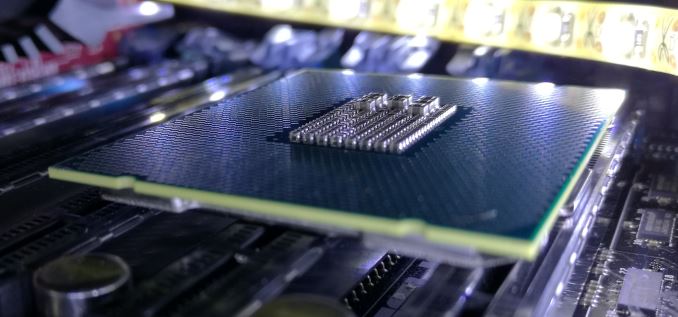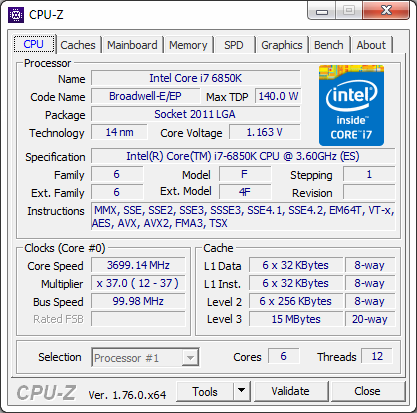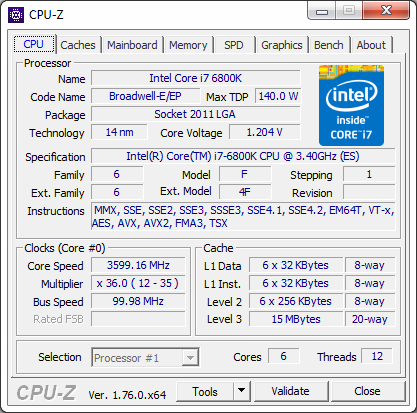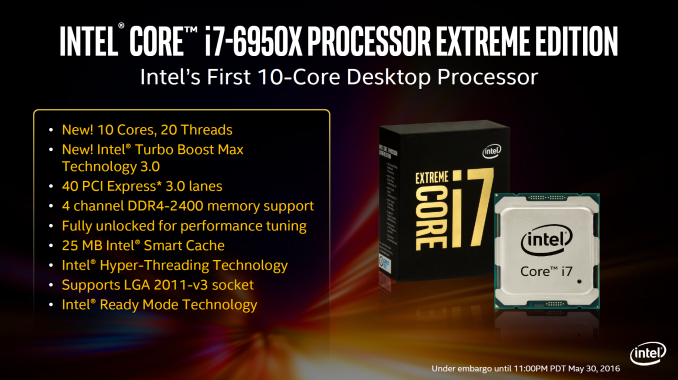The Intel Broadwell-E Review: Core i7-6950X, i7-6900K, i7-6850K and i7-6800K Tested
by Ian Cutress on May 31, 2016 2:01 AM EST- Posted in
- CPUs
- Intel
- Enterprise
- Prosumer
- X99
- 14nm
- Broadwell-E
- HEDT

What would you do with more CPU cores? This is a question I see posted from an Intel employee on a yearly basis, and it actually is a difficult question to answer depending on your computing background. A gamer might not need more than four or six, and a number of workstation use cases are now GPU accelerated. Anyone never in a pure compute situation might not need more than four or six cores.
But what about virtual machines, complex encoding, or non-linear functional compute? How many cores are too many? Intel has recently released the Broadwell-EP based Xeon E5-2600 v4 processors, running up to 22 cores, and the smaller silicon die used for the 10-core parts has today filtered down to the prosumer and high-end desktop (HEDT) markets in four different parts, making up the Core i7 6800 and 6900 series. For today's review we'll be taking a look at all four.
Broadwell-E: The Information
Intel’s HEDT platform cadence has been slowly falling further and further out of phase with their latest CPU microarchitectures. In 2015 we spoke extensively about the successor to Broadwell, Skylake, coming to the consumer and mobile platforms. Now it is 2016, and the HEDT discussion brings us back to Broadwell in the form of Broadwell-E. This out of step cadence occurs for several reasons, namely that the HEDT market is more an extension of the bottom of the enterprise/server market, rather than the extending the reach of the mainstream market. In the enterprise market, customers request stability and updates to appear at regular intervals with sufficient longevity of each platform.
The enterprise market, as Johan reviewed a few weeks ago, uses the name ‘Broadwell-EP’ and comes in three silicon floor plans depending on how many cores are in the final product. Broadwell-E, the HEDT set of processors, takes the smallest 10-core design and splits this into four SKUs to be used in consumer grade X99 motherboards. Most motherboard manufacturers will be releasing their second generation X99 motherboards for this launch, and some have done so already. We have an accompanying piece with this review going over the feature sets of as many new boards as we could find.
But here are the four new SKUs: the 10-core i7-6950X, the 8-core i7-6900K, the 6-core i7-6850K and the 6-core i7-6800K:
| Intel i7 HEDT Lineup | |||||||
| 6950X | 6900K | 6850K | 6800K | 5960X | 4960X | 3960X | |
| Cores | 10 | 8 | 6 | 6 | 8 | 6 | 6 |
| Threads | 20 | 16 | 12 | 12 | 16 | 12 | 12 |
| Base CPU Freq | 3.0 GHz | 3.2 GHz | 3.6 GHz | 3.4 GHz | 3.0 GHz | 3.6 GHz | 3.3 GHz |
| Turbo CPU Freq | 3.5 GHz | 3.7 GHz | 3.8 GHz | 3.6 GHz | 3.5 GHz | 4.0 GHz | 3.9 GHz |
| TDP | 140W | 130W | |||||
| Memory Freq. | DDR4-2400 | DDR4 2133 |
DDR3 1866 |
DDR3 1600 |
|||
| L3 Cache | 25MB | 20MB | 15MB | 15MB | 20MB | 15MB | 15MB |
| PCIe Lanes | 40 | 40 | 40 | 28 | 40 | 40 | 40 |
| Arch. | Broadwell-E | HSW-E | IVB-E | SNB-E | |||
| Price | $1723 | $1089 | $617 | $434 | $999 | $990 | $990 |
There’s a lot of information here to dissect, so let’s start with the one that will catch the most attention: the price.
(1) Price
In order to further separate the high-end desktop platform from their mainstream platforms, Intel has adjusted the pricing of the new Broadwell-E CPUs relative to the previous generations.
The top line 10-core CPU, the i7-6950X, comes in at $1723 at 1k tray pricing, with consumer pricing expected to be nearer $1749 or $1799 depending on stock levels and availability. This is a marked increase from previous top model Extreme Edition processors in the past, which Intel has offered at $999 ($1049 retail). The reasons for the change are somewhat unclear: one could argue that it’s a larger die and costs more to make, but this is the first 14nm HEDT part and should be smaller than an equivalent Haswell-E design. The main reason that springs to mind is simply market and price segmentation – Intel will state that enthusiasts have been asking for more in the overclockable high-end consumer space, so here it is (and here’s the price).
The 10-core is a full $634 more than the 8-core i7-6900K, meaning a 58% increase in price for only 25% increase in cores. We all know that once you reach the high-end, the price/performance curve goes off in a silly direction but if you want to keep the cream of the crop, there is an extra charge.
The i7-6950X also gets a unique retail box compared to the other processors, in a sleek black with gold lettering. This combination of colors tends to go down well with whoever loves gold, perhaps indicating that Intel is looking at a new kind of premium customer.
Moving on to the 8-core i7-6900K, and this part comes in above the previous top price: $1089 compared to $999. This makes it a rough upgrade from any 5960X users when the benefits are limited to the upgraded microarchitecture. As would be expected, while it has fewer cores in play than the i7-6950X, it still allows the base and turbo frequencies to be overclocked for users who run these processors above stock speeds. The processor is still unlocked, but it means a couple of things for users who have a Haswell-E system based on the i7-5960X already: spending another $1000 gets you no extra cores and the same chipset.
Ultimately one could argue that Intel is looking more to Nehalem/Westmere and Sandy Bridge-E users with Broadwell-E, as nearly every Intel presentation usually goes to quote current rates of 3-to-5 year-old systems that need upgrading. There are a few other features that users of Haswell-E systems might be interested in however, which we will cover.
The i7-6850K and i7-6800K are priced at $617 and $434 respectively, marking an increase in price in order to get onto the HEDT ladder from previous generations. These are six core processors, like the i7-5930K and i7-5820K from the previous generation, with similar limitations. The issue Intel has here is that the i7-5820K has been regularly running close or below its MSRP, making it an easy purchase for users that want a HEDT system (if only for the memory support). Making the base i7-6800K a $434 part rather than a ~$320 part means that a minimum outlay for a system (i.e. motherboard + CPU) is closer to $600 than $400, and less attractive to the top segment of mainstream users.
(1b) Xeon Price Competition
I would point out here that Intel is somewhat shooting itself in the foot with the pricing on the i7-6950X. The recently released Xeon Broadwell-EP processor list includes the Xeon E5-2640 v4: a 10-core 2.4 GHz/3.4 GHz part that runs at 90W, and is priced at $939, which compares favorably to the i7-6950X and its 10-cores at a 3.0 GHz/3.5 GHz clockspeeds. And because it’s a Xeon E5 processor processor, with the right motherboard a user can put two into the same machine for 20 cores/40 threads for only $1878, or only $150 more than the 10-core i7-6950X. There are other costs going into the dual processor market, but it opens up a wide margin.
Or how about finding a Xeon at a similar price? Try the Xeon E5-2680 v4 for $1745, which has 14-cores with hyperthreading for 28 threads, runs at 120W TDP and a 2.4 GHz to 3.3 GHz peak frequency. While the frequency is slightly down, that’s a 40% increase in cores for $22, gaining ECC support and a couple of extra hypervisor features in exchange for limiting DRAM to DDR4-2133 and losing overclocking.
The one downside to going the Xeon route is Xeons are only sold as OEM chips with a limited warranty. Intel only wants to sell these through vendors, so very few models ever make it into the retail market (and not always the ones you want).
(2) PCIe Lanes
When Intel introduced Haswell-E, it experimented with a new type of product separation: it also varied the number of CPU-host PCIe lanes among the SKUs. This practice continues in Broadwell-E, in an almost identical fashion. The lowest end CPU has 28 PCIe 3.0 lanes, capable of three-way GPU setups (and no 2x16 setups), while the other processors have a full 40 PCIe 3.0 lanes, allowing for four-way GPU setups or different combinations therein.
Typically the number of users investing in 3-way or 4-way graphics arrangements that implement SLI or Crossfire is very small, with many developers not bothering to optimize for multi-GPU beyond two graphics cards, so it could easily be a moot point for most users. That being said, fewer PCIe lanes means that some slots will have to operate at half bandwidth as a user expands, or users interested in many PCIe devices (GPUs with storage, RAID, and/or 10 gigabit Ethernet) might run out of lanes quicker. But therein lies the product segmentation – if a user need more PCIe lanes, then they need to spend a further $175 for the next processor up.
Back in our Haswell-E review, we did test the effect of having 28 PCIe lanes compared to 40 PCIe lanes on SLI and Crossfire graphics arrangements (or having PCIe 3.0 x16/x8 compared to PCIe 3.0 x16/x16). We found a sub-1% differential for dual-GPU gaming at the time. Due to timing we haven’t repeated the tests with Broadwell-E, and accept that it might matter more with DX12, but ideally we need more games on the market that support the different DX12 multi-GPU modes.
(3) Official Memory Support Increased to DDR4-2400
Within a single socket generation, we typically do not see a change in memory support for successive generations of Intel processors. The ‘official memory support’ of a processor defines the base JEDEC frequency and is the sole guaranteed frequency for the processor that meets the qualified error rates. The reality is that most processors will support faster memory, hence companies like Corsair, G.Skill, Kingston and others offer DDR4-3000 memory kits or faster, for those with bigger wallets. The reason why a CPU manufacturer does not qualify memory at that speed comes down to a number of factors, but as we mentioned, seeing a change within a socket is relatively rare.

One of the new Broadwell-E focused memory modules, a G.Skill TridentZ 16GB DDR4-3200 stick
In this case, the LGA2011-3 socket supports Haswell-E and Broadwell-E processors. The official memory speed supported for Haswell is DDR4-2133, and in our CPU/motherboard tests this is the speed we have been using. For Broadwell-E, this moves up to DDR4-2400, and we’ve sourced DDR4-2400 kits specifically for our testing. Ultimately the performance gain from increasing the memory speed by this small of an amount is minimal for most operations But for those specific use cases that require fast memory (WinRAR compression, RAMDisk/RAMCaches, in-memory virtual machines), they will sometimes see a benefit.
Who is Broadwell-E Aimed At?
Even just looking at the specification sheet, for anyone currently on a modern HEDT system it would be hard to see the value of investing in Broadwell-E unless peak performance is required at any cost. Intel's promotional pitch at launch, and through the length of the platform, will be aimed at users currently still on a Nehalem/Westmere (or even Sandy Bridge-E/Ivy Bridge-E) who want to move up from 4/6 cores and start using the features of the latest X99 platform:
Because of the pricing, it’s clear that the complete cost for a 10-core consumer machine, including memory, storage and graphics, will be a minimum of $2300 for a system with a basic GPU, or nearer $3000 for a high-end gaming platform. Meanwhile we may see Haswell-E in the channel for sale at the lower cost for at least a little while longer, in which case it may be seen as the more price attractive purchase at this time. Although aside from the main specifications, Intel will be hoping that some of the new features will also entice potential purchases.


















205 Comments
View All Comments
Impulses - Tuesday, May 31, 2016 - link
Or just get a 5820K if you'd benefit from the extra cores... Or a 6600/6700K if you want the IPC bump for non gaming tasks and platform upgrades (USB 3.1, more lanes for M.2, etc).After throwing tick tock out the window it's unlikely the next refresh will be any more tempting. If you don't need any of the aforementioned things (more cores or platform upgrades) then you might as well sit tight tho.
rhysiam - Tuesday, May 31, 2016 - link
I've asked this question before and never got a good answer, so I'm trying again. Can someone explain to me why the boost clocks on the SKUs with more cores are always so much lower than those with fewer cores enabled?Base clocks have to be lower of course. I've got no issues with 10 active cores requiring lower clocks than 6 active cores, that makes sense. But what I don't get is why a 10 core SKU with 1 active core and 9 idle is somehow unable to turbo anywhere near as a 6 core implementation which is effectively 1 active core, 5 idle cores and 4 disabled cores on the same silicon . Is the power difference between those 4 idle & disabled cores really so significant on a 140W CPU that it necessitates an almost 10% lower clock speed?
It makes it even harder to justify spending $1.7K on a CPU when it looses so many benchmarks to CPUs costing a fraction of the price (including often the almost 3 year old 4820K).
RealLaugh - Tuesday, May 31, 2016 - link
I would like to know this too, I looked at the frequency and was surprised but I don't understand why it's like that.Also in the past Intel's top like Xeons have had hugh cache + core count but between 2-3GHz clock speeds only...
Ph0b0s - Tuesday, May 31, 2016 - link
Brief go at an explanation. Others can chime in to add on to my very simplistic explanation.The higher cored CPU's having lower clocks is down the to thermal envelope (referred to as TDW in watts) they are trying to hit on that CPU. Each core when working is effectively a heather on the CPU package. On CPU's with more cores, the heaters are more dense, i.e more heaters per area as they try to hit the same physical CPU package size whether 6 or 10 cores.
When all the cores are going a 10 core CPU will generate more heat than a 6 or 4 core CPU when the clocks are the same. To keep the 10 core CPU from hitting the thermal envelope limits that Intel put on them they decrease clock speed to offset the extra heat they are getting from the extra cores.
rhysiam - Tuesday, May 31, 2016 - link
Yes, but the "boost" clocks refer to single (or lightly) threaded workloads. Only one core is working. Your last paragraph refers to "when all the cores are going" - that's a base clock situation. As I said in my post I have no issue at all with 10 active cores requiring a lower frequencies than 6 in the same package. It's the single core taxed scenario I struggle to understand.adamod - Wednesday, June 1, 2016 - link
just a side note....my x5660's are rated at 2.8 base and 3.2 boost and with all 12 cores (dual socket setup) and 24 threads going 100 percent load and pulling 102W ea (while rated at 95W ea) mine NEVER get below 3.1ghz...i somehow got lucky as shit because i have two that can do it and only get to about 80C with the stock cooling on my hp workstation...sometimes you get lucky.....unfortunately i cant overclock though :(ThortonBe - Tuesday, May 31, 2016 - link
Perhaps it is like this. Not every transister has the same performance. When you increase the number of transisters (more cores) you increase the chance that you will get some slower transisters. For the turbo spec every core needs to be able to hit it.By making the turbo spec lower for higher core parts, Intel will have more parts that can be sold as the more expensive part (e.g. with ten cores they have a higher chance of fabricating a slow core than with six cores so they lower the max turbo on the ten cores to compensate to keep yields high).
Also, the floorplans (how the cores are wired up) might differ between the ten and eight core parts. In the GHz even the wiring can severely limit how high a frequency can be achieved. The more complex ten core designs are probably harder to wire up properly.
rhysiam - Wednesday, June 1, 2016 - link
The idea of tolerances with individual cores is an interesting suggestion I hadn't thought of.RE your last paragraph though, my understanding is that all 4 of these SKUs are identical chips, with the lower parts simply having cores (and PCIe lanes) disabled. That was certainly the case with Haswell-E CPUs and I'm assuming the same here. So the 10 core designs are exactly the same as the 6 core.
I suppose it's possible that the 6 core chips undergo testing and have their worst cores disabled, allowing higher turbo frequencies. It just seems, particularly with this generation, that the $1.7K flagship CPU is going to be such a low volume part anyway that they should be able to cherry-pick CPUs which can hit higher boost clocks.
Your suggestion would certainly explain why they're pursuing and promoting "turbo boost max 3.0." It seems like it's a bit of a mess at the moment, but if they can allocate single threaded workloads to the "best" core, surely they could start to hit much better boost clocks?
With Haswell the situation was even worse. You can buy a 4790K which can boost a single core to 4.4Ghz, but the best single threaded Haswell-E option (5930K), despite more the 50W additional TDP to play with and no iGPU for competition has to settle for a full 700mhz (16%) lower on the boost clock. I realise there's additional complexity with the "E" parts with larger cache and a wider memory bus, but that's a massive sacrifice to make that in many cases makes the cheaper 4790K the faster CPU, often by a wide margin.
I'd welcome other thoughts/comments/ideas here.
SAAB340 - Wednesday, June 1, 2016 - link
The 6950X will all have to be well binned to start with. They will all have to have the whole chip working and be able to do so at low voltage enough to meet the 140W TDP. If you have a leakier fully working chip it might still be sold as a 8 or 6 core version given that you just disable 2 or 4 (fully working but leaky) cores to meet the 140W TDP.The Turbo speed bins being lower in general the more cores you get on a CPU is certainly a function of that every individual core will have to be able to hit the highest turbo bin, even though it won't be TDP limited at that time. So you're pretty much guaranteed to be able to overclock to max single core turbo speed but you will most likely exceed the TDP.
It's just the same as that its way harder to find a hexa- octa- or deca-core chip able to reach xGHz overclock on all cores compared to finding a quad-core chip able to reach the same xGHz as 'only' 4 cores have to be good enough overclockers to reach it. The more cores, the less likely when we start to push the limits.
Turbo Boost Max 3.0 is certainly sounding like an interesting function where by the sound of it they instead try to identify the core that is able to run at the highest frequency. Here the opposite would be true, the more cores to choose from the higher likelihood to find one able to reach xGHz.
extide - Monday, June 6, 2016 - link
The floorplan does not differ. All 4 of these sku's use the exact same 10-core die. The lower end ones just have cores disabled, but otherwise they are the same exact silicon.